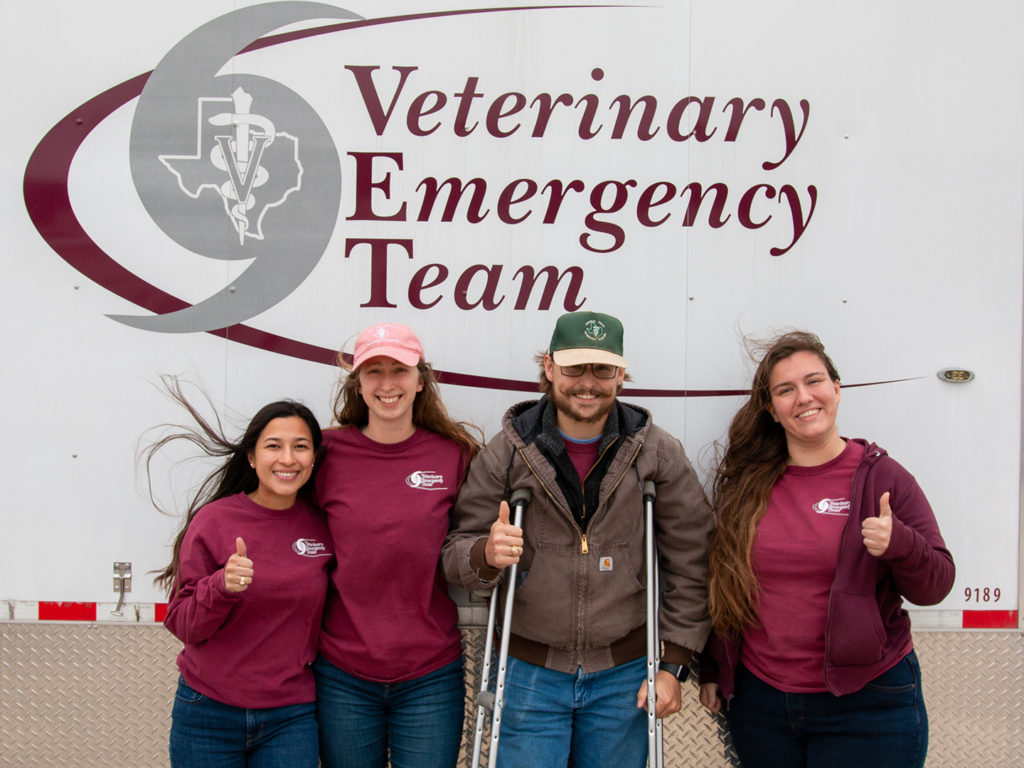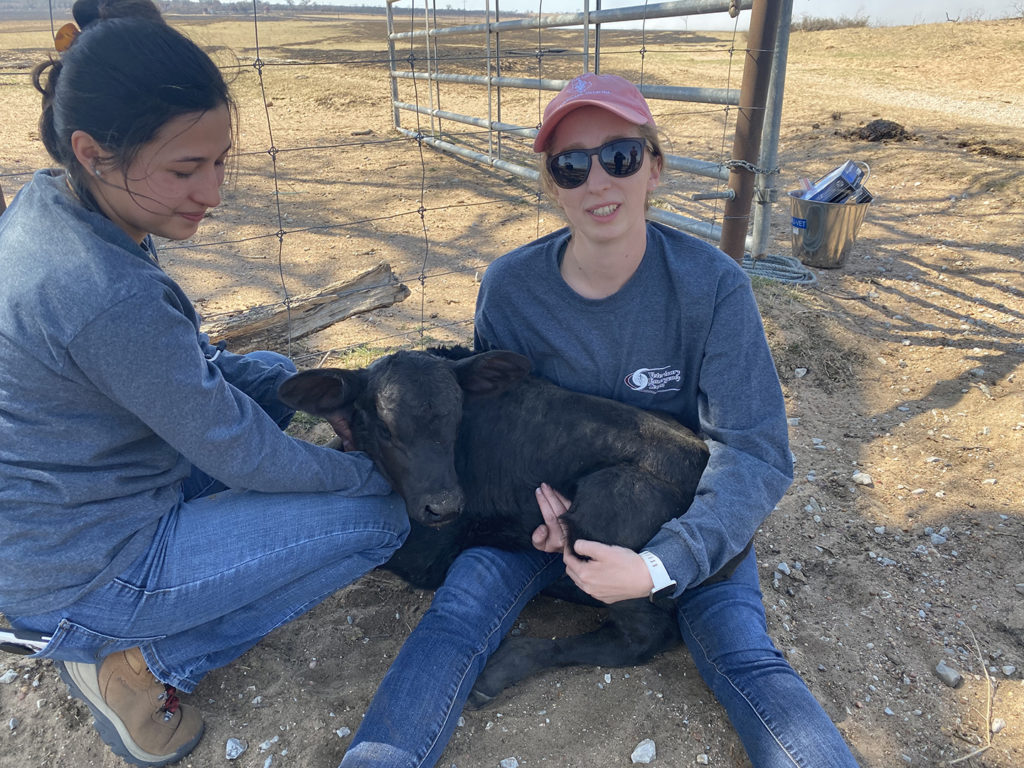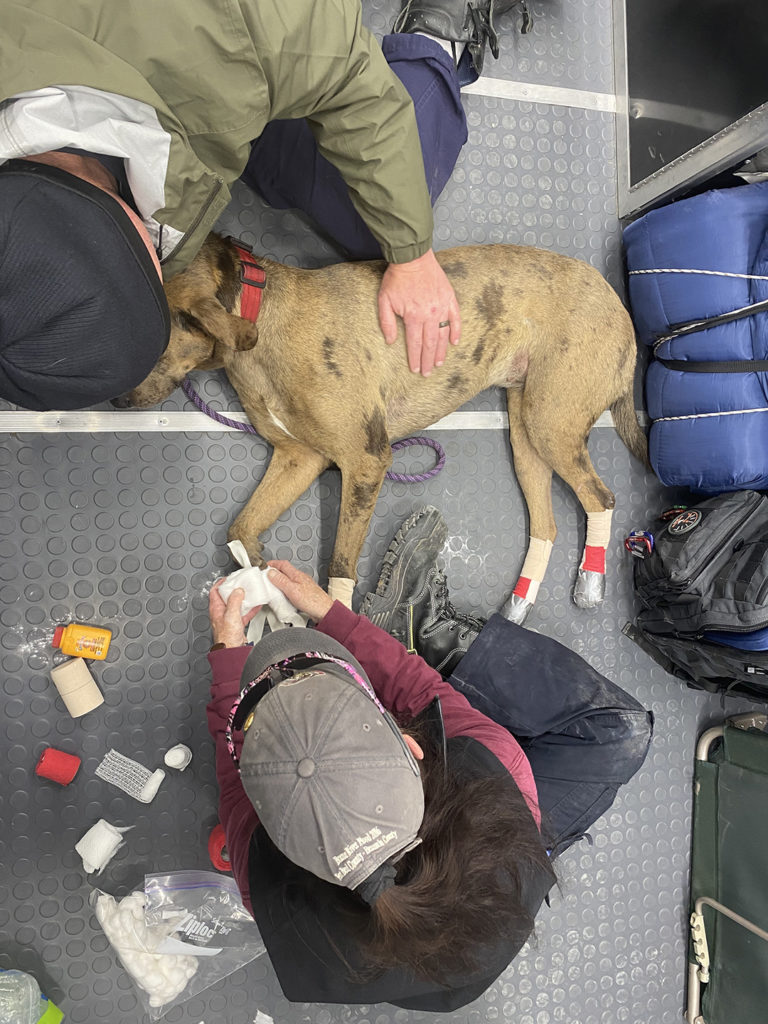Texas A&M VET Treats More Than 200 Animals In Eastland County Fires
Story by Aubrey Bloom, CVMBS Communications

Usually when the Texas A&M College of Veterinary Medicine & Biomedical Sciences’ (CVMBS) Veterinary Emergency Team (VET) arrives at the site of an emergency, the primary danger has already passed, but that wasn’t the case when the team deployed in response to the wildfires in north Texas’ Eastland County.
“The map apps were trying to get us away from the fire, but we were trying to go toward it,” said Kamryn Pursell, one of four fourth-year veterinary students who joined the VET on this deployment. “I didn’t realize how close we were going to be to the wildfires until our navigation apps kept trying to reroute us.”
The students arrived on March 20, and just that day three new fires sprang up and high winds rapidly expanded the already existing fires, requiring the team to continually make preparations to move in case the fires spread their direction while they saw what would eventually total more than 210 animals.
As a result, Pursell and classmate Jessica Olivarez, who were assigned to the large animal operation, didn’t have time for an orientation when they arrived in Eastland.
“Everything was happening superfast,” Olivarez said. “We basically dropped our bags off and headed out to the first set of coordinates and didn’t come back until after dark.”
Ongoing Emergency
The large animal response, a priority for the VET because of the large amounts of cattle in the region, faced a number of obstacles, including the ongoing wildfires. With the smoky conditions making it difficult for teams on the ground to see, they had to rely on aerial spotters looking for signs of live animals.
Because the fires spread so quickly, many residents were left with little time to organize evacuations of livestock animals, so the scenes that awaited the VET were devastating.
“It was incredibly sad, so we had to focus on what we could do to help,” Olivarez said.

It was a tough assignment even for an experienced veterinarian like Dr. Laurie Shelton, who has volunteered on several VET deployments.
“Sunday was a rough day,” she said. “But the students rallied, they got dirty with the rest of us, they were willing to do some really hard work. I think they grew a lot as veterinarians in just a few hours and showed a ton of resilience.”
At one location, Olivarez and Pursell helped deliver a healthy calf, but even while Olivarez was treating it, a small fire crept toward her. Pursell went for help and the fire was put out.
The calf was later evacuated to a safe location, where the owner plans to bottle feed it.
Shelton said that during a tough deployment, one thing might happen to give you hope and that the students found that in the calf they later named Smoky.
“That calf was kind of a survivor story; it really helped them rally and be OK,” Shelton said. “Even with a lot going wrong, there are still good outcomes we can focus on.”
As difficult as it was, Olivarez and Pursell said they wished they could have stayed out longer.
“We were out until it was dark,” Pursell said. “That was tough, too, because you want to keep going—you want to keep helping—but when the sun is going down, you’re in danger because of the fires, so it’s just not safe to stay.”
Close To Home

Fourth-year student Matthew Lewis wasn’t even supposed to deploy during his clinical rotation with the VET. Recovering from meniscus surgery and on crutches, Lewis and VET leadership had decided on his first day that if a deployment came, he was going to stay home.
However, as the week progressed, Lewis kept up with the news because his hometown of Brownwood was in the affected area. He even sent screenshots of the news to the other students, saying the fire looked like the kind of event the VET would be activated for.
The texts proved prescient; less than 12 hours later, the team was activated, and with the VET headed near his hometown, Lewis couldn’t sit it out.
“Even if I couldn’t really do anything, I wanted to be able to see the response up close,” he said. “I really wish I could’ve done more. I had been trying to stay updated on what parts of the community were affected and where the fires were starting. It’s intense and it hits close to home. Luckily, my family wasn’t in the path, but I know a lot of people who were.”
Lewis was assigned to the small animal operation with classmate Samantha Lowrey, and they, too, faced their own challenges.
“We saw a dog from a couple who had barely escaped their home,” Lowrey said. “They lost four dogs, but they found this fifth one. He had some burns, but we were able to patch him up. They were afraid they weren’t going to be able to afford medical treatment or find someone to take care of the dog, but we were able to help them, even if it’s only a small help.”
What seems like a small help is often actually a huge help, which is one of the defining traits of the VET, according director Dr. Wesley Bissett.
“I always tell our team and our students that you’re often seeing someone on their very worst day,” he said. “If you can make that worst day even a little bit better, if you can give them that little bit of hope, it can make a big difference.”
Along with treating household pets for burns, the students also helped care for and prepare the search and rescue dogs deployed in the area through things such as bandaging their paws, which was especially important because of hot spots on the ground or areas where fire may still have been burning.
Valuable Experience
When the initial call came, it didn’t take long for the students to say “yes,” and now that the deployment is over, they have a much deeper understanding of how emergency response works.
“One of the reasons a lot of us go into veterinary medicine is because we want to help people and our communities,” Lowrey said. “When you see a disaster happening, you want to help however you can. This deployment has given me a much deeper understanding of how exactly that happens and an understanding of why systems are in place. If you don’t know the system, you can actually do a lot more harm than good.”
Lowrey also said her time with the VET gave her a deeper appreciation for being an Aggie because of how involved different Texas A&M entities are in disaster response.
“I’m an Aggie, my parents are Aggies, and even I didn’t realize how involved Texas A&M was in emergency response,” she said. “You get here and there’s Texas A&M AgriLife Extension helping organize emergency food for livestock, the Texas A&M Forest Service providing the fire containment updates, and more. You really see how deeply Texas A&M is involved in helping the state of Texas.”
###
For more information about the Texas A&M College of Veterinary Medicine & Biomedical Sciences, please visit our website at vetmed.tamu.edu or join us on Facebook, Instagram, and Twitter.
Contact Information: Jennifer Gauntt, Director of VMBS Communications, Texas A&M College of Veterinary Medicine & Biomedical Sciences, jgauntt@cvm.tamu.edu, 979-862-4216


